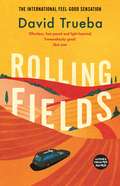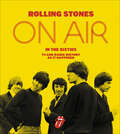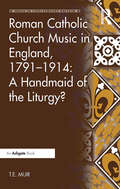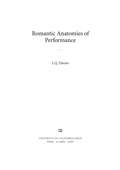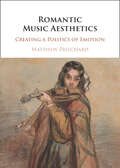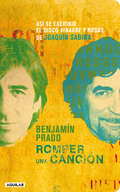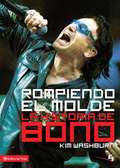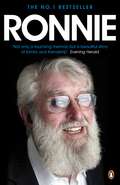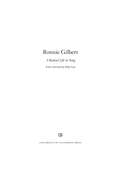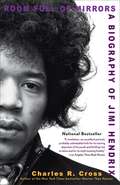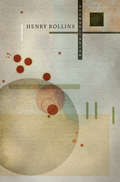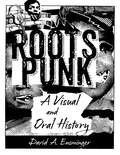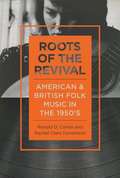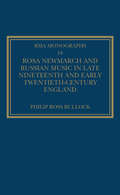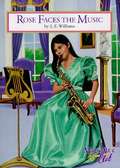- Table View
- List View
Rolling Fields
by David TruebaWINNER OF AN ENGLISH PEN AWARD'Effortlessly readable and fizzing with energy, this novel is by turns quirky, funny and thoughtful'Mail on Sunday Dani Mosca is 40 and his father has just died. Fulfilling his father's last wishes, Dani embarks on a road trip back to his childhood village, a three-hour hearse journey from Madrid. Leaving behind the busy streets of the city for the deserted, archaic heart of Spain, Dani revisits the key junctions of his life: his conflicted relationship with a pragmatic and authoritarian father; the mystery of his birth; his school years in the repressed atmosphere of Catholic Spain; the origin of his band and its early successes; the emptiness left by a tragically lost friendship; his great loves. Laugh-out-loud funny, deeply moving and featuring an unforgettable cast of characters - from Ecuadorian drivers to Spanish Bowie lookalikes - Rolling Fields is a novel full of the grace and messiness of life: brave, exciting and completely irresistible.Translated from Spanish by Rahul Bery
Rolling Fields
by David TruebaWINNER OF AN ENGLISH PEN AWARD'Effortlessly readable and fizzing with energy, this novel is by turns quirky, funny and thoughtful'Mail on SundayDani Mosca is 40 and his father has just died. Fulfilling his father's last wishes, Dani embarks on a road trip back to his childhood village, a three-hour hearse journey from Madrid. Leaving behind the busy streets of the city for the deserted, archaic heart of Spain, Dani revisits the key junctions of his life: his conflicted relationship with a pragmatic and authoritarian father; the mystery of his birth; his school years in the repressed atmosphere of Catholic Spain; the origin of his band and its early successes; the emptiness left by a tragically lost friendship; his great loves. Laugh-out-loud funny, deeply moving and featuring an unforgettable cast of characters - from Ecuadorian drivers to Spanish Bowie lookalikes - Rolling Fields is a novel full of the grace and messiness of life: brave, exciting and completely irresistible.Translated from Spanish by Rahul Bery
Rolling Stones All the Songs: The Story Behind Every Track (All the Songs)
by Jean-Michel Guesdon Philippe MargotinComprehensive visual history of the "World's Greatest Rock & Roll Band" as told through the recording of their monumental catalog, including 29 studio and 24 compilation albums, and more than a hundred singles.Since 1963, The Rolling Stones have been recording and touring, selling more than 200 million records worldwide. While much is known about this iconic group, few books provide a comprehensive history of their time in the studio. In The Rolling Stones All the Songs, authors Margotin and Guesdon describe the origin of their 340 released songs, details from the recording studio, what instruments were used, and behind-the-scenes stories of the great artists who contributed to their tracks. Organized chronologically by album, this massive, 704-page hardcover begins with their 1963 eponymous debut album recorded over five days at the Regent Studio in London; through their collaboration with legendary producer Jimmy Miller in the ground-breaking albums from 1968 to 1973; to their later work with Don Was, who has produced every album since Voodoo Lounge. Packed with more than 500 photos, All the Songs is also filled with stories fans treasure, such as how the mobile studio they pioneered was featured in Deep Purple's classic song "Smoke on the Water" or how Keith Richards used a cassette recording of an acoustic guitar to get the unique riff on "Street Fighting Man."
Rolling Stones on Air in the Sixties: TV and Radio History As It Happened
by Richard HaversThe first official, in-depth history of the Rolling Stones told through the band’s television and radio broadcasts—appearance by appearance—published to tie in with the global release of a DVD containing recently discovered, never-before-released footage of the Stones on TV, in front of and behind the cameras.The Rolling Stones on Air in the Sixties is a unique chronicle of the band’s rise to fame during the 1960s. It begins with a letter the BBC received from Brian Jones in January 1963, politely requesting an audition for "The Rollin’ Stones Rhythm and Blues Band," and ends with the story of the group’s performance of "Let It Bleed" for BBC’s end-of-the-decade celebration television program Ten Years of What.From their first television appearance on Thank Your Lucky Stars!, sporting matching houndstooth suits at the insistence of manager Andrew Loog Oldham, to the louche rockers who performed at a televised free concert in London’s Hyde Park in 1969, The Rolling Stones on Air in the Sixties reveals, year-by-year, how the group rose from obscurity to dominate rock-and-roll. Throughout, the Stones look back at their career-defining broadcasts, sharing their individual recollections about the music, the clothes, the fans, the rivals and friends, and the impact they had on the generational divide and the world around them. This remarkable collection features previously unseen facsimile documents from the BBC and commercial archives, exclusive interviews with directors and producers who worked with the band during their rise, and showcases many stunning images never before seen. This is history as it happened, both in front of and behind the camera, and on and off the studio mic. Viewing the band from a fresh and unusual viewpoint that makes their story both immediate and vivid, The Rolling Stones on Air in the Sixties offers invaluable insights into one of the greatest great rock ’n’ roll bands the world has ever seen.
Roman Catholic Church Music in England, 1791–1914: A Handmaid of the Liturgy? (Music in Nineteenth-Century Britain)
by T.E. MuirRoman Catholic church music in England served the needs of a vigorous, vibrant and multi-faceted community that grew from about 70,000 to 1.7 million people during the long nineteenth century. Contemporary literature of all kinds abounds, along with numerous collections of sheet music, some running to hundreds, occasionally even thousands, of separate pieces, many of which have since been forgotten. Apart from compositions in the latest Classical Viennese styles and their successors, much of the music performed constituted a revival or imitation of older musical genres, especially plainchant and Renaissance Polyphony. Furthermore, many pieces that had originally been intended to be performed by professional musicians for the benefit of privileged royal, aristocratic or high ecclesiastical elites were repackaged for rendition by amateurs before largely working or lower middle class congregations, many of them Irish. However, outside Catholic circles, little attention has been paid to this subject. Consequently, the achievements and widespread popularity of many composers (such as Joseph Egbert Turner, Henry George Nixon or John Richardson) within the English Catholic community have passed largely unnoticed. Worse still, much of the evidence is rapidly disappearing, partly because it no longer seems relevant to the needs of the modern Catholic Church in England. This book provides a framework of the main aspects of Catholic church music in this period, showing how and why it developed in the way it did. Dr Muir sets the music in its historical, liturgical and legal context, pointing to the ways in which the music itself can be used as evidence to throw light on the changing character of English Catholicism. As a result the book will appeal not only to scholars and students working in the field, but also to church musicians, liturgists, historians, ecclesiastics and other interested Catholic and non-Catholic parties.
Romantic Anatomies of Performance
by James Q. DaviesRomantic Anatomies of Performance is concerned with the very matter of musical expression: the hands and voices of virtuosic musicians. Rubini, Chopin, Nourrit, Liszt, Donzelli, Thalberg, Velluti, Sontag, and Malibran were prominent celebrity pianists and singers who plied their trade between London and Paris, the most dynamic musical centers of nineteenth-century Europe. In their day, performers such as these provoked an avalanche of commentary and analysis, inspiring debates over the nature of mind and body, emotion and materiality, spirituality and mechanism, artistry and skill. J. Q. Davies revisits these debates, examining how key musicians and their contemporaries made sense of extraordinary musical and physical abilities. This is a history told as much from scientific and medical writings as traditionally musicological ones. Davies describes competing notions of vocal and pianistic health, contrasts techniques of training, and explores the ways in which music acts in the cultivation of bodies..
Romantic Music Aesthetics: Creating a Politics of Emotion
by Matthew PritchardThis book reassesses the place of politics and emotion within Romantic music aesthetics. Drawing together insights from the history of emotions, cultural history, and studies of philosophical idealism, 'affective relationality' – the channelling of emotion through music's social and cultural synergies – emerges as key to Romantic aesthetic thought. Now familiar concepts such as theatrical illusion, genius, poetic criticism, and the renewed connection of art to mythology and religion opened new spaces for audiences' feelings, as thinkers such as Rousseau, Herder, Germaine de Staël, Joseph Mainzer, Pierre Leroux and George Sand sought alternatives to the political status quo. Building on the sentimental tradition in eighteenth-century art and politics, the Romantics created ways of listening to music imbued not just with melancholic longing for transcendence but also with humour, gothic fantasy, satire, and political solidarity. The consequences have extended far beyond the classical concert hall into numerous domains of popular culture from melodrama, romances and political songwriting to musical theatre and film.
Rome (Solo Motets from the Seventeenth Century Series)
by Anne SchnoebelenThe appearance of the solo voice in church music in 1602, in Lodovico da Viadana’s Cento concerti ecclesiastici, initiated a development that would soon parallel secular solo song. This series of Italian solo motets makes available for the first time many of these rich sources of seventeenth-century sacred music. The series spans the major part of the seventeenth century, from 1621 to 1695. It includes works by composers from major cities and provincial towns. Three composers are represented by multiple collections: Maurizio Cazzati (6); Bonifazio Graziani (6); and Isabella Leonarda (5). In each case, the solo motet forms a major component in that composer’s oeuvre; their collections provide comprehensive "textbooks" for the study of the genre.
Romper una canción: Así se escribió el disco Vinagre y rosas, de Joaquín Sabina
by Benjamín PradoUn día, a principios del año 2009, Joaquín Sabina y Benjamín Prado decidieron irse a Praga a escribir canciones y siete meses después habían acabado el disco Vinagre y rosas. Este libro cuenta esa aventura que fue puro rock and roll, llena de versos y versos tachados, chicas que vienen y que se van, viajes, música, alcohol, risas y, sobre todo, lleno de una amistad sin fronteras ni direcciones prohibidas. Y también nos deja ver los talleres de cada canción y nos hipnotiza haciéndonos mirar las vueltas que dieron todas ellas antes de quedar acabadas. Benjamín Prado rememora en Romper una canción la intensidad de aquellos meses de trabajo en los que Sabina y él pelearon a muerte por cada palabra y llegaron a lograr una combustión y una simbiosis tan profundas que hoy día ninguno de ellos sabe quién escribió qué, porque no hay una coma sin negociar en todo el disco. Así se escribió Vinagre y rosas.
Rompiendo el molde, la historia de Bono
by Kim WashburnLA HISTORIA DE UN MUCHACHO DE DUBLÍN QUE SE CONVIRTIÓ EN UNA DE LAS MAYORES ESTRELLAS DE ROCK DEL PLANETA Y NO SE CONFORMÓ CON SER SOLAMENTE UN CANTANTE Premios, fama, riquezas… ¡Bono pareciera tenerlo todo! Pero la mayor estrella de rock del mundo confiesa tener algo todavía más importante que ha guiado cada uno de sus pasos hacia el éxito: la fe en Dios. Desde su crianza en Irlanda en tiempos realmente peligrosos, hasta tocar en los mayores escenarios del mundo, las creencias de Bono lo han mantenido arraigado y enfocado en lo que verdaderamente importa. Ya sea usando su voz para cautivar a la audiencia o luchando por la justicia y la salud en África, el mundo sabe que además de cantar, Bono es un defensor de los perdidos y un héroe para los que pelean por un mundo más justo.
Ronnie
by Ronnie DrewThe late great Dubliner, Ronnie Drew, was six months into writing his biography when he was diagnosed with cancer. He had produced warm, witty and insightful material that made it clear that he was a wonderful writer as well as a great singer and storyteller. With the encouragement of his wife Deirdre and his family, he continued to think about the book and conducted a number of interviews to keep things ticking over until he was well enough to resume work on it. But sadly, much as he wanted to, Ronnie did not get to finish his story.However, with the whole-hearted co-operation of his daughter and son, Cliodhna and Phelim, it has been possible to put together Ronnie's work on his memoir along with his other writings, interviews with Cliodhna and Phelim, a wealth of photographs and other material from the family archive, and contributions from close friends, to create a book that is a wonderful portrait of, and a fitting and loving tribute to, the man Bono called 'the king of Ireland'.
Ronnie Gilbert
by Ronnie GilbertRonnie Gilbert had a long and colorful career as a singer, actor, playwright, therapist, and independent woman. Her lifelong work for political and social change was central to her role as a performer. Raised in Depression-era New York City by leftist, working-class, secular Jewish parents, Gilbert is best known as a member of the Weavers, the quartet of the 1950s and '60s that survived the blacklist and helped popularize folk music in America. Her joyous contralto and vibrant stage presence enriched the celebrated group and propelled Gilbert into a second singing career with Holly Near in the 1980s and '90s. As an actor, Gilbert explored developmental theater with Joseph Chaikin and Peter Brook and wrote and performed in ensemble and solo productions across the United States and Canada.Ronnie Gilbert brings the political, artistic, and social issues of the era alive through song lyrics and personal stories, traversing sixty years of collaborations in life and art that span the folk revival, the Cold War blacklist, primal therapy, the back-to-the-land movement, and a rich, multigenerational family story. Much more than a memoir, Ronnie Gilbert is a unique and engaging historical document for readers interested in music, theater, American politics, the women's movement, and left-wing activism.
Room Full of Mirrors: A Biography of Jimi Hendrix
by Charles R. CrossNow in paperback, the national bestselling biography of American musical icon Jimi HendrixIt has been more than thirty-five years since Jimi Hendrix died, but his music and spirit are still very much alive for his fans everywhere. Charles R. Cross vividly recounts the life of Hendrix, from his difficult childhood and adolescence in Seattle through his incredible rise to celebrity in London's swinging sixties. It is the story of an outrageous life--with legendary tales of sex, drugs, and excess--while it also reveals a man who struggled to accept his role as idol and who privately craved the kind of normal family life he never had. Using never-before-seen documents and private letters, and based on hundreds of interviews with those who knew Hendrix--many of whom had never before agreed to be interviewed--Room Full of Mirrors unlocks the vast mystery of one of music's most enduring legends.
Roomanitarian
by Henry RollinsIn Roomanitarian, popular author, actor, musician, and spoken-word artist Henry Rollins returns to the combative prose that has won him critical acclaim and a legion of devoted fans. The book is divided into three parts: The first section, "Walking the Chasm," written in the form of a poem, epitomizes Rollins's beautifully stark, hard-hitting style. The second part, "Ended," is a series of short prose pieces reminiscent of Solipsist. Finally, the biting humor and social commentary Rollins is renowned for is on full display in "To Ann Hitler with Love," a series of mock love letters to a fictional woman who bears a striking resemblance to conservative pundit Ann Coulter.
Roots Punk: A Visual and Oral History (American Made Music Series)
by David A. EnsmingerPunk rock evokes dissent and disruption, abrasive and anarchic musicality, and a host of countercultural aesthetics. Featuring original interviews and over one hundred images, Roots Punk: A Visual and Oral History by longtime music journalist and author David A. Ensminger focuses on how punk merged with roots music to create a rich style that incorporated honky-tonk, rockabilly, doo-wop, reggae, ska, jazz, folk, blues, and labor ballads. This engagement transformed the notion of punk to include a wide array of vintage source material that seems more aligned with bolo ties and Stetsons than Doc Martens and safety pins. Ensminger explores the music’s aesthetics, traits, and themes. He contextualizes, clarifies, maps, and probes roots punk’s hybrid nature as well as its diverse, queer-inclusive, and multicultural strains. By painting a broad, nuanced, and well-documented picture of the genre from its earliest incarnation, he forms a kind of people’s history of the movement. Roots Punk features original interviews with members of Minutemen, MDC, the Dicks, the Plimsouls, Tex and the Horseheads, Dils/Rank and File, X, the Flesh Eaters, Beatnigs, Alejandro Escovedo, Robert “El Vez” Lopez, Blasters, and more. Whether covering sarcastic novelty forms or sincere embraces, Ensminger reveals and revels in a punk tradition lined with blues records, acoustic ballads, country, and hillbilly romp. In a time of growing conformity, replication, and commercialization, roots punk (sometimes dubbed cow-punk) offers a tantalizing revitalization and reimagination of the American songbook.
Roots and Rhythm: A Life in Music
by Charlie PeacockA beautifully crafted memoir unveiling the ancestral, musical, and spiritual roots of Grammy Award-winning music producer Charlie Peacock. In this artful memoir, Grammy Award–winning music producer Charlie Peacock flexes his literary chops and gives readers the gritty backstage stories they crave: biographical anecdotes, geeky trivia, and how the hits were written and recorded (from jazz to rock and pop). Threaded throughout is Peacock&’s unique ancestral and spiritual story—the roots. Like Coltrane, Dylan, and Bono before him, Peacock reveals a Christ-affection while refusing genres too small for his music. Peacock, the great-grandson of a Louisiana fiddler, is an American musical polymath. He&’s been the young jazz musician sitting at the feet of trumpeter Eddie Henderson and pianist Herbie Hancock; the singer-songwriter plucked from the Northern California punk/pop underground by legendary impresarios Bill Graham and Chris Blackwell; a pioneering, innovative contributor to the nascent rise of gospel rock in the 1980s; and the genre-busting producer behind such diverse artists as Al Green, Ladysmith Black Mambazo, Chris Cornell, Audio Adrenaline, The Civil Wars, Switchfoot, Turtle Island Quartet, and John Patitucci.Roots and Rhythm includes Peacock&’s seminal NorCal days, the story of indie labels Exit and re:think, his first decade as a Nashville producer (1989–1999), and his essential role in the 21st-century folk/Americana boom (The Civil Wars, Holly Williams, The Lone Bellow). While his exploits and achievements grace the book (including the story of Amy Grant&’s &“Every Heartbeat&” and the evergreen &“In the Light&”), Peacock is hardly the only character. Instead, he writes as a Joan Didion-style essayist, weaving together a quintessential American story. Beat poet Gary Snyder, evangelist Billy Graham, producer T Bone Burnett, saxophonist Wayne Shorter, and writers Wendell Berry and Isabel Wilkerson all appear in this sweeping tale where ancestry, migration, teenage love, Jesus, and Miles Davis collide. The book is an invitation to all, including aspiring musicians: embrace the roots and rhythm of our own lives, letting the music and God&’s insistent love lead us to gratitude and wonder.
Roots of the Revival: American and British Folk Music in the 1950s (Music in American Life)
by Ronald D Cohen Rachel Clare DonaldsonIn Roots of the Revival: American and British Folk Music in the 1950s, Ronald D. Cohen and Rachel Clare Donaldson present a transatlantic history of folk's midcentury resurgence that juxtaposes the related but distinct revivals that took place in the United States and Great Britain. After setting the stage with the work of music collectors in the nineteenth century, the authors explore the so-called recovery of folk music practices and performers by Alan Lomax and others, including journeys to and within the British Isles that allowed artists and folk music advocates to absorb native forms and facilitate the music's transatlantic exchange. Cohen and Donaldson place the musical and cultural connections of the twin revivals within the decade's social and musical milieu and grapple with the performers' leftist political agendas and artistic challenges, including the fierce debates over "authenticity" in practice and repertoire that erupted when artists like Harry Belafonte and the Kingston Trio carried folk into the popular music mainstream. From work songs to skiffle, from the Weavers in Greenwich Village to Burl Ives on the BBC, Roots of the Revival offers a frank and wide-ranging consideration of a time, a movement, and a transformative period in American and British pop culture.
Rosa Newmarch and Russian Music in Late Nineteenth and Early Twentieth-Century England (Royal Musical Association Monographs #18)
by PhilipRoss BullockPhilip Ross Bullock looks at the life and works of Rosa Newmarch (1857-1940), the leading authority on Russian music and culture in late nineteenth- and early twentieth-century England. Although Newmarch's work and influence are often acknowledged - most particularly by scholars of English poetry, and of the role of women in English music - the full range of her ideas and activities has yet to be studied. As an inveterate traveller, prolific author, and polyglot friend of some of Europe's leading musicians, such as Elgar, Sibelius and Jan�k, Newmarch deserves to be better appreciated. On the basis of both published and archival materials, the details of Newmarch's busy life are traced in an opening chapter, followed by an overview of English interest in Russian culture around the turn of the century, a period which saw a long-standing Russophobia (largely political and military) challenged by a more passionate and well-informed interest in the arts Three chapters then deal with the features that characterize Newmarch's engagement with Russian culture and society, and - more significantly perhaps - which she also championed in her native England; nationalism; the role of the intelligentsia; and feminism. In each case, Newmarch's interest in Russia was no mere instance of ethnographic curiosity; rather, her observations about and passion for Russia were translated into a commentary on the state of contemporary English cultural and social life. Her interest in nationalism was based on the conviction that each country deserved an art of its own. Her call for artists and intellectuals to play a vital role in the cultural and social life of the country illustrated how her Russian experiences could map onto the liberal values of Victorian England. And her feminism was linked to the idea that women could exercise roles of authority and influence in society through participation in the arts. A final chapter considers how her late interest in the music of Czechoslovakia pi
Rose Faces the Music (Magic Attic Club)
by L. E. WilliamsOn another adventure through the mirror in the magic attic, Rose finds herself chosen to play a saxophone solo in a jazz performance at the presidential inaugural celebration.
Rosie and the Dance of the Dinosaurs
by Betty Ren WrightThe big piano recital is coming up soon, and Rosie feels anything but ready—&“captures the down-to-earth rhythms of suburban life, spiced with humor&” (Kirkus Reviews). Even though Rosie has only nine fingers, she&’s always managed well. Until now. For some reason, she can&’t master the piano solo she&’s been rehearsing for the annual recital. It&’s called &“The Dance of the Dinosaurs,&” and it&’s hard! As the recital draws near, Rosie is desperate. Why does everything seem so much more difficult now? Is it because she misses her father? Since he moved to Milwaukee to take a new job, Rosie&’s been miserable, and her mother has been acting kind of strange. Or is Rosie having trouble because she&’s worried about the burglar who&’s been secretly visiting her house? Then, too, there&’s Mary Jean, the new girl in town. Not only is she rich and pretty, but she plays the piano beautifully. In the weeks before the recital, Rosie fights some hard battles. To her surprise, she discovers that having nine fingers isn&’t such a bad thing after all.
Rotten: No Irish, No Blacks, No Dogs
by Keith Zimmerman Kent Zimmerman John Lydon"I have no time for lies and fantasy, and neither should you. Enjoy or die..." --John LydonPunk has been romanticized and embalmed in various media. An English class revolt that became a worldwide fashion statement, punk's idols were the Sex Pistols, and its sneering hero was Johnny Rotten.Seventeen years later, John Lydon looks back at himself, the Sex Pistols, and the "no future" disaffection of the time. Much more than just a music book, Rotten is an oral history of punk: angry, witty, honest, poignant, crackling with energy. Malcolm McLaren, Sid Vicious, Chrissie Hynde, Billy Idol, London and England in the late 1970s, the Pistols' creation and collapse...all are here, in perhaps the best book ever written about music and youth culture, by one of its most notorious figures.
Rough Ideas: Reflections on Music and More
by Stephen HoughA collection of essays on music and life by the famed classical pianist and composerStephen Hough is one of the world’s leading pianists, winning global acclaim and numerous awards, both for his concerts and his recordings. He is also a writer, composer, and painter, and has been described by The Economist as one of “Twenty Living Polymaths.”Hough writes informally and engagingly about music and the life of a musician, from the broader aspects of what it is to walk out onto a stage or to make a recording, to specialist tips from deep inside the practice room: how to trill, how to pedal, how to practice. He also writes vividly about people he’s known, places he’s traveled to, books he’s read, paintings he’s seen; and he touches on more controversial subjects, such as assisted suicide and abortion. Even religion is there—the possibility of the existence of God, problems with some biblical texts, and the challenges involved in being a gay Catholic.Rough Ideas is an illuminating, constantly surprising introduction to the life and mind of one of our great cultural figures.
Rounding Wagner's Mountain
by Bryan GilliamRichard Strauss' fifteen operas, which span the years 1893 to 1941, make up the largest German operatic legacy since Wagner's operas of the nineteenth century. Many of Strauss's works were based on texts by Europe's finest writers: Oscar Wilde, Hugo von Hofmannsthal and Stefan Zweig, among others, and they also overlap some of the most important and tumultuous stretches of German history, such as the founding and demise of a German empire, the rise and fall of the Weimar Republic, the period of National Socialism, and the post-war years, which saw a divided East and West Germany. In the first book to discuss all Strauss's operas, Bryan Gilliam sets each work in its historical, aesthetic, philosophical, and literary context to reveal what made the composer's legacy unique. Addressing Wagner's cultural influence upon this legacy, Gilliam also offers new insights into the thematic and harmonic features that recur in Strauss's compositions.
Rousseau Among the Moderns: Music, Aesthetics, Politics
by Julia SimonRenowned for his influence as a political philosopher, a writer, and an autobiographer, Jean-Jacques Rousseau is known also for his lifelong interest in music. He composed operas and other musical pieces, invented a system of numbered musical notation, engaged in public debates about music, and wrote at length about musical theory. Critical analysis of Rousseau’s work in music has been principally the domain of musicologists, rarely involving the work of scholars of political theory or literary studies. In Rousseau Among the Moderns, Julia Simon puts forth fresh interpretations of The Social Contract, the Discourse on the Origin of Inequality, and the Confessions, as well as other texts. She links Rousseau’s understanding of key concepts in music, such as tuning, harmony, melody, and form, to the crucial problem of the individual’s relationship to the social order. The choice of music as the privileged aesthetic object enables Rousseau to gain insight into the role of the aesthetic realm in relation to the social and political body in ways often associated with later thinkers. Simon argues that much of Rousseau’s “modernism” resides in the unique role that he assigns to music in forging communal relations.
Rousseau Among the Moderns: Music, Aesthetics, Politics
by Julia SimonRenowned for his influence as a political philosopher, a writer, and an autobiographer, Jean-Jacques Rousseau is known also for his lifelong interest in music. He composed operas and other musical pieces, invented a system of numbered musical notation, engaged in public debates about music, and wrote at length about musical theory. Critical analysis of Rousseau’s work in music has been principally the domain of musicologists, rarely involving the work of scholars of political theory or literary studies. In Rousseau Among the Moderns, Julia Simon puts forth fresh interpretations of The Social Contract, the Discourse on the Origin of Inequality, and the Confessions, as well as other texts. She links Rousseau’s understanding of key concepts in music, such as tuning, harmony, melody, and form, to the crucial problem of the individual’s relationship to the social order. The choice of music as the privileged aesthetic object enables Rousseau to gain insight into the role of the aesthetic realm in relation to the social and political body in ways often associated with later thinkers. Simon argues that much of Rousseau’s “modernism” resides in the unique role that he assigns to music in forging communal relations.
